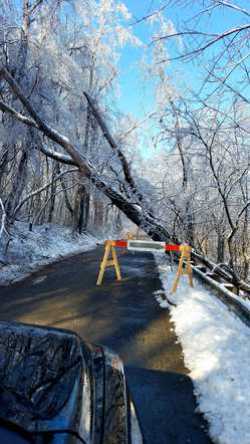 It is a beautiful time of year when we wake up many mornings pleasantly surprised to see a fresh, clean blanket of snow highlighting the dull browns and evergreens of winter. You may enjoy the beauty of the snow, the peacefulness of the landscape, or the fun of playing in the snow, so there really is something for everyone when the winter weather comes.
It is a beautiful time of year when we wake up many mornings pleasantly surprised to see a fresh, clean blanket of snow highlighting the dull browns and evergreens of winter. You may enjoy the beauty of the snow, the peacefulness of the landscape, or the fun of playing in the snow, so there really is something for everyone when the winter weather comes.
However, there is one point on which many people dread to see this weather come-driving. Driving can be treacherous when a snow or ice storm comes. Whether it be because of slippery roads or fallen trees, accidents are much more likely. Robinette Legal Group, PLLC is committed to helping those injured in accidents to get the help they need, but the better option is certainly to not get in an accident in the first place, so here are some tips to help you drive more safely in winter weather, and get back to enjoying the beauty of the snow.
When Can the Roads Be Dangerous in Winter?
Clearly, roads can be dangerous during and after snow and ice storms, but there are other threats that are not as obvious that make the roads especially dangerous because they are often not realized. These include near-freezing temperatures and falling branches.
Near-freezing temperatures. When the temperature falls below freezing and it is snowing, there is always the possibility of slippery road conditions, even if the roads appear to be clear. According to the University of Washington, however, there are several circumstances in which the roads may be slippery even when the temperature is above freezing. The key reason for this is that most temperatures reported are taken at approximately five feet above ground. Depending on the wind and other factors, this can be significantly different from the temperature of the ground. It could even vary up to five degrees, meaning that roads could be icy when reported temperatures are 37 degrees.
Drivers should especially use caution when the temperature is near the dew point as the frost left below freezing temperatures is a very thin layer of ice. Even more caution should be exercised when conditions are foggy. Fog above the ground can leave a somewhat thicker and much more slippery layer of ice on the roads due to the cooler surface temperature.
Also, watch carefully for water standing on the roads, as this will quickly freeze into a smooth, treacherous layer of ice. This can come from various sources including recent rainfall, snow that melted during the day and is refreezing at night, or roads with poor drainage.
Another commonly overlooked danger of near-freezing temperatures is that ice is much more slippery near its freezing point. This is because there is a very thin layer of water sitting on top of the ice, making it nearly frictionless. Remember that the road temperature is often significantly cooler than reported air temperatures, so not only are roads potentially slippery but are potentially the worst they could possibly be when the reported temperatures are above freezing, so drivers need to be especially cautious when temperatures are in the mid to lower 30s.
Winter Safe Driving Practices
The best thing to do when the roads are dangerous is to avoid traveling as much as possible, but when this is not an option, here are some tips to help you drive more safely.
Easy with the pedals. The gas and the brake pedals’ functions are to make the vehicle change speed, which is something vehicles do not do as well on slippery roads. When accelerating, push the gas gently to avoid spinning the tires. When braking, allow room to brake slowly so sliding is not as much of an issue.
Look ahead while driving for hills and curves. Try to slow down naturally without using the brake before curves. Also, pick up a safe amount of speed when possible before going uphill to reduce the chance of needing to use the gas, and reduce speed before going downhill. Learn how to use the gearshift to manage speed, even if you have an automatic transmission, so that you can gear down before going down a hill. This will make the transmission more safely hold the vehicle back and will reduce braking which is much more likely to start the vehicle sliding.
What to do when sliding. It is good to know just in case what to do if your vehicle does start sliding on ice. The first thing to do is not panic. Sliding can be very scary, but response to it needs to be as quick and accurate as possible. Next, be sure not to brake. The car is already sliding and locking up the wheels is not going to help it stop at this point. The next step is to turn your steering wheel the same direction as the back of the vehicle is sliding. As the vehicle begins to straighten and possibly snaps in the other direction, respond accordingly by continuing to turn the steering wheel in the direction the back of the vehicle is sliding.
Preparing for an Emergency
No matter how hard you try, vehicle crashes on slippery roads can happen, and accident scenes can quickly become emergencies when weather is severe. That is why it is important to be prepared. Kane and Silverman have a useful list of items to keep in your vehicle in the winter to help in a winter emergency. Here are listed the items that can help when stuck in winter weather.
- Shovel and sand – Keeping a shovel in the car could be very useful to get going again as soon as possible. If the wheels are spinning, use a shovel to dig out under the vehicle. Sand or another substance that can help the vehicle grip can help get the vehicle going when placed right around the tires.
- First aid kit – This is good to keep in the car all the time. First aid kits are specially designed to have items needed in an emergency situation.
- Tool kit, including jumper cables – Like a first aid kit, these are also good to have in the car year-round. Having a specific tool to make a minor repair might keep you off the side of the road for hours in the cold waiting for a tow truck.
- Visibility equipment – Keeping flares, a flashlight, or something to make you visible could prevent further accidents, especially in low visibility weather such as heavy snow. Also, a flashlight can be a very useful tool for many other reasons.
- Warm clothes, blankets, food, and water – Severe weather might leave you stranded for some time, so be sure to have food and water and something to keep you warm for at least a few hours.
- Charged phone – Keep your phone charged to be able to reach out for help in an emergency.
Winter is a beautiful time of year, so do everything you can to be sure it stays safe. Stay off potentially dangerous roads as much as possible, learn about how to drive safely on them, keep your vehicle stocked with necessary items for an emergency, and enjoy the snow!
Jeffery Robinette was admitted to practice law in 1991 and is licensed in all levels of state and federal trial courts in West Virginia. Mr. Robinette is also licensed in all state and federal appeals courts in West Virginia and the United States Supreme Court. As a National Board Certified Trial Attorney who has handled hundreds of motor vehicle, injury, and construction defect claims and a leading author on insurance claims settlement issues and difficulties in West Virginia, Jeff Robinette is uniquely qualified to represent your best interest.




